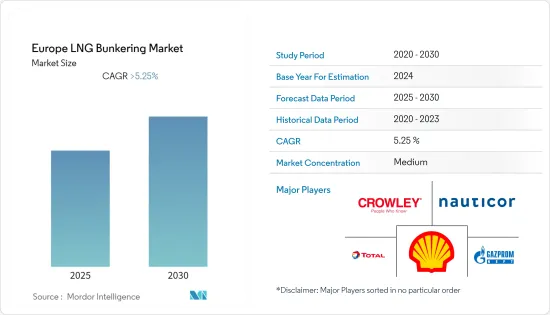Need help finding what you are looking for?
Contact Us
PUBLISHER: Mordor Intelligence | PRODUCT CODE: 1630419

PUBLISHER: Mordor Intelligence | PRODUCT CODE: 1630419
Europe LNG Bunkering - Market Share Analysis, Industry Trends & Statistics, Growth Forecasts (2025 - 2030)
PUBLISHED:
PAGES: 100 Pages
DELIVERY TIME: 2-3 business days
SELECT AN OPTION
The Europe LNG Bunkering Market is expected to register a CAGR of greater than 5.25% during the forecast period.

The COVID-19 outbreak negatively impacted the market due to regional lockdowns. Currently, the market reached pre-pandemic levels.
Key Highlights
- Stringent environmental regulations imposed by local government bodies and IMO to curb emissions, coupled with the abundant natural gas availability, are expected to stimulate the industry growth of the market studied.
- However, some countries lack of LNG bunkering infrastructure will likely hinder the market during the forecast period.
- The orders and deliveries of LNG-powered vessels are increasing, and the reduced natural gas prices marked the beginning of expanding opportunities for such vessels in the coming years.
- During the forecast period, Norway is expected to dominate the LNG bunkering market in Europe.
Europe LNG Bunkering Market Trends
Ferries & OSV Segment to Dominate the Market
- Ferries are vessels used to carry cargo across the water. A passenger ferry is used as a water bus or taxi to travel from one place to another. Various ferries include double-ended, hydrofoil, hovercraft, catamaran, roll-on/ roll-off, cruise ferry (RoPax), fast RoPax ferry, and others.
- These vessels majorly operate on heavy fuel oil and marine gas oil. However, government regulations regarding the emission of sulfur, carbon dioxide, and other pollutants encourage using LNG as fuel in vessels.
- In the next five years, the LNG-based ferries and OSVs are projected to increase, considering the large number of LNG-fueled ferries and OSVs on order. It is likely to increase the demand for LNG bunkering services in the forecast period.
- European Green Deal, formed in 2019 by the European Commission, is a set of policy initiatives to make Europe carbon neutral by 2050. It briefly underlines the importance of LNG for achieving this aim and emphasizes the usage of LNG as fuel for trucks and marine vessels.
- However, with the regulations related to sulfur content in the fuel, the option of using LNG is attractive to these types of vessels. It is because of the operating profile and economic, regulatory, and environmental reasons.
Norway to Dominate the Market
- Norway is always a pioneer country in the global LNG bunkering market. In 2000, the world's first LNG-fueled vessels, the Glutra car and passenger ferry, were made operational in Norway. Seventeen years later, in 2017, Hammerfest, Europe's largest dedicated LNG bunkering station with 1250 m3 storage and a pump capacity of 90 tons/hour, was operational in Norway.
- The focus on climate issues remains high in Norway. The Norwegian government is setting ambitious and stern emission norms to align itself with the greenhouse gas emissions targets of the Paris Agreement and within the EU emission standards.
- To counter the increasing global concerns regarding the harmful emission of pollutants from marine transportation, Norway invested early in LNG ships and was helped by the Norwegian NOx fund. The Norwegian government initiated it.
- Moreover, the country's government is focusing on exporting LNG through a pipeline to other European countries to reduce the domination of Russia in the region. In early 2020, the pipeline system operator, Gassco, announced that the company approved its LNG pipeline to boost its small-scale LNG exports from the Arctic Barents Sea.
- Hence, this significantly increased the demand for LNG bunkering facilities in Norway during the forecast period.
Europe LNG Bunkering Industry Overview
The Europe LNG bunkering market is moderately consolidated. Some of the major players in this market (in no particular order) include Royal Dutch Shell Plc, Total SA, Crowley Maritime Corporation, Nauticor GmbH & Co. KG, and Gazpromneft Marine Bunker LLC.
Additional Benefits:
- The market estimate (ME) sheet in Excel format
- 3 months of analyst support
Product Code: 71257
TABLE OF CONTENTS
1 INTRODUCTION
- 1.1 Scope of the Study
- 1.2 Market Definition
- 1.3 Study Assumptions
2 RESEARCH METHODOLOGY
3 EXECUTIVE SUMMARY
4 MARKET OVERVIEW
- 4.1 Introduction
- 4.2 Market Size and Demand Forecast in USD billion, till 2028
- 4.3 Recent Trends and Developments
- 4.4 Government Policies and Regulations
- 4.5 Market Dynamics
- 4.5.1 Drivers
- 4.5.2 Restraints
- 4.6 Supply Chain Analysis
- 4.7 Porter's Five Forces Analysis
- 4.7.1 Bargaining Power of Suppliers
- 4.7.2 Bargaining Power of Consumers
- 4.7.3 Threat of New Entrants
- 4.7.4 Threat of Substitutes Products and Services
- 4.7.5 Intensity of Competitive Rivalry
5 MARKET SEGMENTATION
- 5.1 End-User
- 5.1.1 Tanker Fleet
- 5.1.2 Container Fleet
- 5.1.3 Bulk and General Cargo Fleet
- 5.1.4 Ferries and OSV
- 5.1.5 Others
- 5.2 Geography
- 5.2.1 Norway
- 5.2.2 Spain
- 5.2.3 Netherlands
- 5.2.4 United Kingdom
- 5.2.5 Rest of Europe
6 COMPETITIVE LANDSCAPE
- 6.1 Mergers and Acquisitions, Joint Ventures, Collaborations, and Agreements
- 6.2 Strategies Adopted by Leading Players
- 6.3 Company Profiles
- 6.3.1 Shell Plc
- 6.3.2 TotalEnergies SE
- 6.3.3 Crowley Maritime Corporation
- 6.3.4 Nauticor GmbH & Co. KG
- 6.3.5 Harvey Gulf International Marine LLC
- 6.3.6 ENN Energy Holdings Ltd
- 6.3.7 Engie SA
- 6.3.8 Gazpromneft Marine Bunker LLC
7 MARKET OPPORTUNITIES AND FUTURE TRENDS
Have a question?


SELECT AN OPTION
Have a question?


Questions? Please give us a call or visit the contact form.
